Day 1 of a 3 day long weekend of tours today. The middle of November traditionally marks the time when autumn starts to merge into winter, at least as far as the migration season is concerned. However, there are sill birds on the move, arriving here for the winter, and there is still the odd lingering migrant yet to move on. It was a gloriously sunny day today, even warm at times, a perfect day to get out and see some of those birds.
We started at Burnham Overy Staithe. As we climbed up onto the seawall,a small bird flew past us and into the bushes below. It was a Chiffchaff. Presumably a late migrant, it seemed to be in a hurry to be on its way and disappeared off down the line of bushes in a series of long flights. A Common Buzzard perched in a large bush out on the grazing meadows, enjoying the morning sunshine.
 Fieldfare – in the bushes by the seawall at Burnham Overy Staithe
Fieldfare – in the bushes by the seawall at Burnham Overy Staithe
There were lots of Blackbirds in the hawthorns below the seawall, presumably winter migrants arrived from the continent and stopped to refuel on berries. As we walked along, we heard first the tchacking of a Fieldfare, which we found perched in the top in the sunshine, and then the teezing of several Redwings, most of which were less obliging. A Song Thrush completed the set.
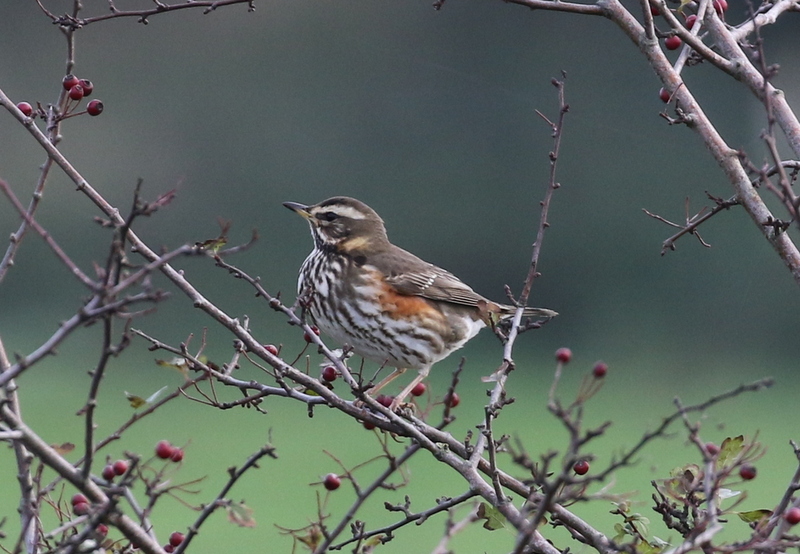 Redwing – several were also feeding in the bushes below the seawall
Redwing – several were also feeding in the bushes below the seawall
Looking out over the other side, in the harbour, we stopped to look through the waders. The tide was out, so there was lots of exposed mud. First we picked up a Grey Plover with a lone Ringed Plover over on the far bank. Then several more Ringed Plovers appeared, and started to bathe in the shallow water, with a Redshank conveniently close by for size comparison. A little further along, at the bend in the seawall, we could see a good sized flock of Dunlin out on the larger mudflats, feeding feverishly.
As we walked past, we flushed a Little Egret from the near edge of the harbour channel, and it flew out to the mud, flashing its yellow feet as it went. In the channel, we found four Little Grebes together. They proceeded to haul themselves out onto the far bank – always off to see Little Grebes on dry land, they look so ungainly.
 Little Egret – with bright yellow feet
Little Egret – with bright yellow feet
Several Rock Pipits had flown around calling, but typically dropped down out of view. Finally one dropped down in front of us and perched nicely on a pile of rocks, appropriately enough! Through the scope, we could see its plain, oily brown upperparts and the dirty ground colour to its black-streaked underparts. We get a lot of Scandinavian Rock Pipits, of the subspecies littoralis, coming to Norfolk for the winter, but we don’t have any British petrosus breeding here.
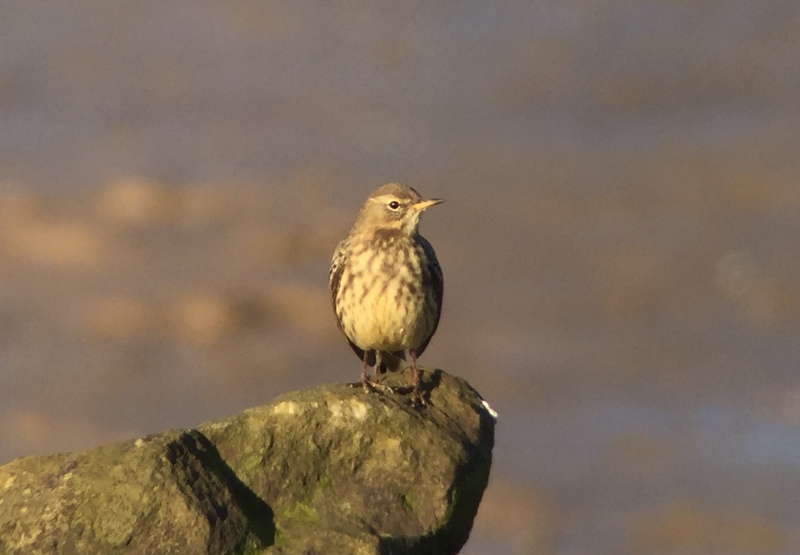 Rock Pipit – eventually one perched up nicely for us on a pile of rocks
Rock Pipit – eventually one perched up nicely for us on a pile of rocks
There were lots of Wigeon out on the grazing marshes. As we stopped to have a look at them in the scope, we could hear them whistling – a real sound of winter on the marshes here. There were plenty of geese too. We were looking straight into the sun on the walk about but we could still see lots of Brent Geese, Pink-footed Geese and Greylags. In with them were 12 Barnacle Geese, presumably feral birds from Holkham Park.
As we passed the reedbed, we could hear Bearded Tits calling but, despite the lack of wind, they were not to be seen. A Cetti’s Warbler shouted at us, but was similarly elusive. At least the Reed Buntings were slightly easier to see. A Marsh Harrier perched in one of the bushes at the back of the reeds and another one or two flew backwards and forwards across the channel to and from the saltmarsh beyond.
There were lots of Starlings on the move today, little flocks passing west overhead constantly on the walk out. Some were not flying so directly as they sometimes do, instead taking advantage of the warm conditions to try to catch flies on the way. A small flock of Golden Plover flew over calling and dropped down on the grass by the dunes. When we got there, we got them in the scope and found a little covey of six Grey Partridges with them!
When we got to the dunes, we turned left and walked out towards Gun Hill. The Isabelline Wheatear was still present earlier in the morning – it has been here for three weeks now – but had not been seen for over an hour when we arrived. Could it have taken advantage of the sunny weather finally to continue its journey? We decided to have a walk round the dunes to see if we could find it.
There was no sign of it where it had been feeding for the past couple of weeks. From the northern edge of the dunes, we stopped to look out towards the sea. We could see lines of wildfowl flying in, migrants arriving for the winter. There were several groups of Brent Geese and a larger flock of Wigeon coming in. A line of around twenty Eider flying west over the sea was a nice bonus, particularly as it included a couple of smart drakes.
There were lots of waders down on the beach. There were plenty of Oystercatcher and a few Sanderling out on the sand. Down around the tidal channel, we found a little mixed flock of Knot and Dunlin – a nice opportunity to compare their relative sizes. Several Turnstones had gathered for a bath.
Out at the point, looking out towards Scolt Head, we picked up two Red Kites circling out over the saltmarsh. They seemed too concerned with swooping at each other to worry about the Marsh Harrier which was trying to have a go at them. There were a few people standing on the top of Gun Hill looking for the Isabelline Wheatear, and as we turned to walk back one of the locals started waving to us. It had reappeared!
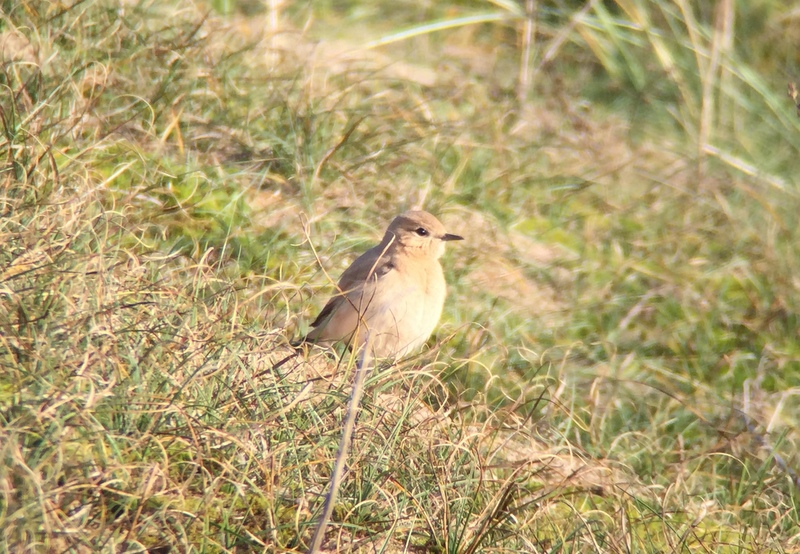 Isabelline Wheatear – looking very sandy in the sun
Isabelline Wheatear – looking very sandy in the sun
We stopped to scan in the direction they were all looking and there was the Isabelline Wheatear on the edge of the saltmarsh. It looked particularly pale and sandy in the sunshine. It flitted around the bushes for a few seconds and then disappeared off behind the Suaeda. It was proving very mobile because, by the time we got over to the others, it had flown again to the other side of Gun Hill. We had some nice views of it on the grass and back down to the edge of the saltmarsh again before suddenly it was off again. It flew off up over Gun Hill and disappeared.
It was around this time that we heard trilling and looked up to see a Waxwing heading towards us. It flew over our heads and carried on west, unfortunately without stopping.
Having had good views of the Isabelline Wheatear, we decided to walk round onto the beach and head back along the tideline to see what we could find. We didn’t find any Snow Buntings today, but we did come across the Isabelline Wheatear again. The reason we couldn’t find it earlier in the dunes was because it was now out on the beach! There were lots of flies buzzing around the high tide line, and it was busy catching them. Chasing up and down the beach, occasionally flying up after a fly.
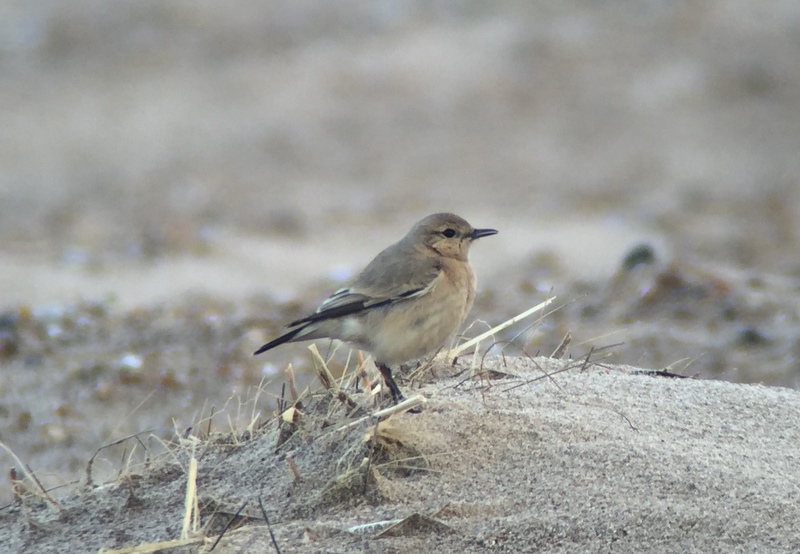 Isabelline Wheatear – catching flies out on the beach today
Isabelline Wheatear – catching flies out on the beach today
We watched it for a while, but in the end had to tear ourselves away and head back, taking a detour via the base of the dunes to avoid disturbing it. We walked quickly back along the seawall, stopping briefly to watch a large flock of Linnets and Goldfinches whirling around over the saltmarsh. When they landed, we could see several Golden Plover out there too, surprisingly well camouflaged, despite the bright golden-spangled upperparts we could see through the scope.
The light was better on the walk back, so we stopped at the corner to look at the geese again. This time, we found four White-fronted Geese in with the Pinkfeet. One had its head up for a while, so we could see its pink bill surrounded at the base with white, but then they all went to sleep. Then it was back for lunch, led along the seawall by a pair of Stonechats which flew ahead of us. We ate our lunch sat on the benches looking out over the saltmarsh back towards Gun Hill – a stunning view!
 Stonechat – a pair led us back along the seawall
Stonechat – a pair led us back along the seawall
After lunch, we drove back round to Holkham. There were lots of Pink-footed Geese out on the grazing marshes east of Lady Anne’s Drive. While most were distant, a little group of about a dozen were right next to the road, so we stopped for a close look. We could see their pink legs and delicate dark bills with encircled with a pink band.
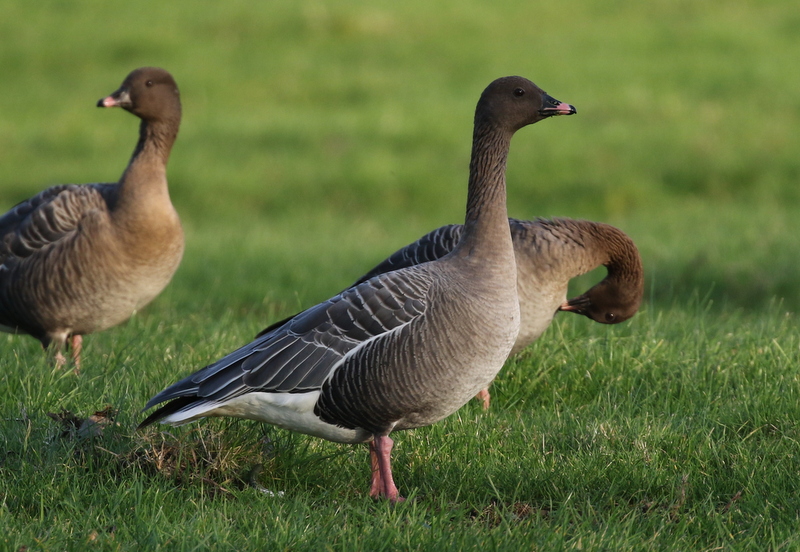 Pink-footed Goose – showing very well close to Lady Anne’s Drive
Pink-footed Goose – showing very well close to Lady Anne’s Drive
As we walked through the pines, we could hear Goldcrests calling high up in the pines. A Jay flew across and started scolding from the trees the other side. Out on the saltmarsh, a large flock of Linnets was whirling round, reluctant to settle.
A little further along, we came across a small group of Brent Geese. Looking through them, we quickly found the Black Brant x Dark-bellied Brent hybrid which is regular here. It is not as dark or contrasting as a pure Black Brant but is still subtly darker bodied, with a slightly bolder flank patch and more obvious though not complete collar. In with them too was a single Pale-bellied Brent Goose. When it turned, we could see the bold wing stripes which meant it was a juvenile. Along with several or our regular Russian Dark-bellied Brents, that meant we had 2 1/2 subspecies of Brent Goose in one very small flock!
 Black Brant hybrid – out on the saltmarsh at Holkham
Black Brant hybrid – out on the saltmarsh at Holkham
At the eastern end of the saltmarsh, we found the Shore Larks in their usual place. We could see several of them flying around before we got there, but when we got closer we noticed there were lots more still down on the ground. There was a mass of bright yellow faces, shining beautifully in the late afternoon sunshine. Shore Larks are always stunning birds, but it was fantastic to watch so many of them in such great light, a real treat.

They were feeding in the slightly taller vegetation today, picking seeds from the dried seedheads of the saltmarsh flowers. Several of the Shore Larks were hidden from view, which made it harder to get an accurate count, but there were at least 65 today and very probably a few more that we missed. After years of declining numbers it is great to see so many back again this year. While we were watching the Shore Larks, a Tawny Owl started hooting from the pines beyond, a reminder that days are short now.
Out at the beach, the tide was in. There was a surprising amount of swell, given how little wind there was today, which meant we had to climb up into the dunes to get a higher vantage point. Even from there, the ducks kept disappearing in the waves. We did manage to find a couple of Long-tailed Ducks which were not too far out. The large flocks of Common Scoter were more distant but little groups kept flying around and a flash of white in the wing alerted us to two Velvet Scoters in with one of them. They landed on the sea and we could see them in the scope before they started diving and disappeared into the larger flock.
We could see several Great Crested Grebes on the sea too. A little flock of Cormorants flew overhead, heading in to roost. Then it started to get a little misty and, with the light fading, became increasingly difficult to pick out anything different. We decided to head back to the other side of the pines.
Lots of Pink-footed Geese could be heard calling as we walked back through the pines. There was a lovely view across the marshes, with low-lying mist enveloping the bases of the hedges and trees. We watched and waited for a while, with several smaller groups of geese flying in and whiffling down. Then we picked up some bigger skeins in the distance and several thousand flew in together, in a cacophony of yelping calls. Perhaps put off by the mist, several groups flew straight over, perhaps heading out to roost on the flats instead. Many of the others did drop down and disappear into the mist.
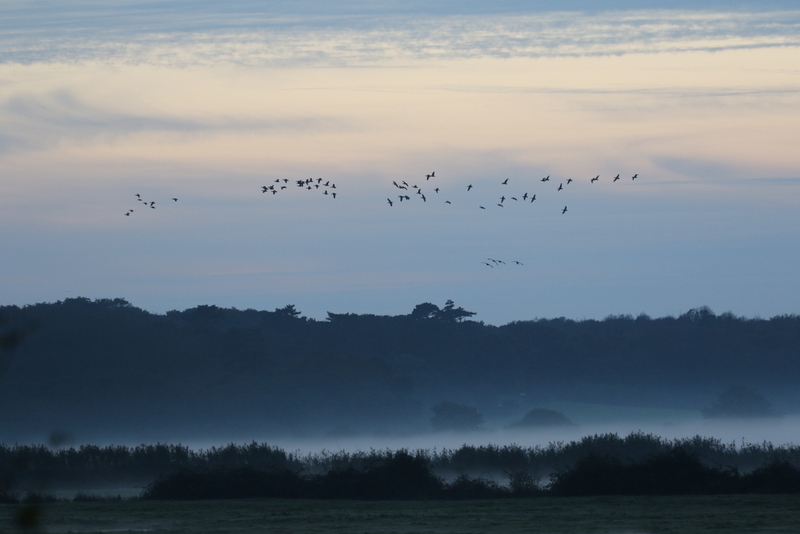 Pink-footed Geese – dropping down in the mist to roost
Pink-footed Geese – dropping down in the mist to roost
It is quite a sight and sound to watch the Pink-footed Geese coming in to roost on a winter’s evening. Then, with the light fading, we headed for home.
















